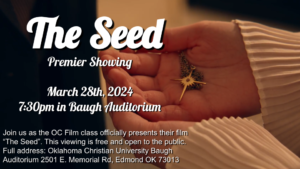Online Photo
Some say there’s no terror quite like running from a tornado with no safe place to hide. Edmond’s solution? A storm shelter in every public school.
Sophomore Emily Kennedy attended Central Middle School, and during her time there the school had a close call with a tornado. She explained how the teacher in her classroom had the students go to the front of the room, which was partially underground.
“I think being in the middle of Tornado Alley, [putting in tornado shelters] is a really good idea,” Kennedy said. “Especially if they’re going to make us stay on campus. [If] they’re not going to let us leave, then they need to have a safe place for everyone.”
The tornado tragedy in Moore last May has proven to be one of the key factors in pushing the installation of storm shelters. Ideally, every Edmond public school will build a storm shelter.
The schools that do not currently have independent storm shelters still have procedures to follow when the occasion calls for them.
“With the advanced weather predictions, of course we are able to monitor severe storms hours days in advance,” Edmond Public Schools Public Information Officer Susan Parks-Schlepp said. “And so our district safety coordinator will send out various communication to school sites; as the weather approaches, we are able to make minute-by-minute decisions.”
Even with all the preparation and time that goes into planning for tornadoes, there is still the fear that it will not be enough.
“There are a lot of times where you just never think it’s going to happen to you,” senior and longtime Edmond resident Daniel Griffin said.
Since the proposed storm shelters will serve dual functions, one of the major concerns about this project is the cost.
“Funding is an issue, most definitely,” Parks-Schlepp said. “Providing safe rooms in every school is not an inexpensive proposition. We are probably looking at tens of millions in our district and we are one of roughly 500 school districts in our state.”
While the estimated cost of these shelters is large, it is important to remember the reward involved with having them in schools, according to junior and longtime Edmond resident Emma Axtell.
“I think it would be worth it when it saves lives,” Axtell said. “It’s kind of hard to put a price on a life. Granted, it is very, very expensive, but … I think it is worth it no matter what the amount is. I think that because safety, especially safety of children, is very important and to be prioritized.”
Some have speculated that the call for tornado shelters is simply a response against a single incident, such as last spring’s tornado.
“The storm in May heightened peoples’ awareness of the destruction of a tornado, as well as what it could do to a school,” Parks-Schlepp said. “It also brought to the forefront their fears of, ‘Are my children safe at school during the school day?’”
While keeping students safe is priority, Griffin emphasized that the fact tornadoes often hit when school is out of session should also be taken into consideration.
“If they do put it in, it could be a good shelter for the community, even if it is after hours,” Griffin said. “I hope that they would see that as opportunity to help out the community. Even if the tornado doesn’t hit during school, it’s a safe place for the people around the school to be.”
Currently six elementary schools and one high school in Edmond are without a storm shelter.
Since Oklahoma is considered part of Tornado Alley, Oklahoma Christian University has also been looking into additional safety advancements for its campus.
“Sometimes a disaster like that drives home to you what’s important and what matters,” Vice President and Dean of Student Life Neil Arter said. “And it’s kind of like [how] the events of 9/11 has changed the way that air travel happens now – it’s a little inconvenient and it’s probably a little more expensive, but it’s what you have to do.”
There are numerous places on campus where students could take shelter if the occasion arose, such as the Davisson American Heritage Building auditorium, the Prince Engineering Center and the interior first-floor hallways of the dormitories.
When the tornadoes hit last spring, the staff of Oklahoma Christian put all proposed solutions on the table.
“Days after the Moore tragedy we started looking at all kinds of options,” Arter said. “…We’ve looked at areas on our campus that we can fortify, so that’s one of the things, what areas can we beef up that we currently have. The next thing is to have plans for everything that you build from here on, just like the schools are doing, … you build in a storm shelter function in those areas.”
While storm shelters are necessary for withstanding weather under these conditions, Oklahoma Christian students are responsible for themselves and for getting to safety.
“OC is going to tell you what to do and things, but the truth is, you’ve got to do it,” Arter said. “We can’t come and pick you up and take you to shelter … you’ve got to do it yourself.”












Be First to Comment